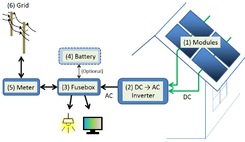Solar power in Tennessee


Solar power in Tennessee is capable of producing much of the state's electricity; however, the industry remains in early stages in the state. With 129 MW of solar power in 2015, Tennessee ranked 20th among states for installed solar capacity.[2]
The largest solar installations in Tennessee are the 20 MW Selmer and 20 MW Mulberry Solar Farms in McNairy County, both built in 2014.[2] In 2013, Volkswagen opened an 8 MW solar farm at its assembly plant in Chattanooga.[3] In 2012, Tennessee's largest solar installation was the 5 MW West Tennessee Solar Farm.[4]
A 68.5 MW(DC) (53 MW(AC)) solar farm is under construction near Millington with expected completion in 2017.[5]
Rooftop solar
Photovoltaic panels installed on rooftops is estimated to be capable of producing 23% of all electricity used in Tennessee,[6] with 16,000 MW of solar panels.[7] TVA has a Generation Partners Program that pays $1000 on sign up and $0.12/kWh above retail for photovoltaic systems of from 0.5 kW to 50 kW. Payments are for 10 years and are credited to customers monthly bill and paid either monthly or annually.[8]
Federal law requires net metering upon request, but Tennessee is one of only four states without established policy, meaning that it needs to be negotiated with the utility. A more practical approach is to assume net metering by each utility. Net metering is simply an accounting procedure, and the only requirement is a bi-directional electric meter. Most meters are bi-directional. It is more practical for utilities to discover net metering instead of requiring registration and reporting, just as there is no registration or reporting requirement in connecting an air conditioner, which is instead discovered by utilities. Best practices call for perpetual roll over of kilowatt credits instead of converting to a monetary value.[9]
A 2012 estimate suggests that a typical 5 kW system will pay for itself in about 14 years, and thereafter generate a net savings of $16,622 over the 25 year life of the system.[10]
Statistics

|
| Tennessee Photovoltaics Capacity (MWp)[12][13][14][15][16][17] | ||||||||||||
|---|---|---|---|---|---|---|---|---|---|---|---|---|
| Year | Capacity | Installed | % Change | |||||||||
| 2007 | 0.4 | 0 | 0% | |||||||||
| 2008 | 0.4 | 0 | 0% | |||||||||
| 2009 | 0.9 | 0.5 | 125% | |||||||||
| 2010 | 5.7 | 4.8 | 533% | |||||||||
| 2011 | 22.0 | 16.3 | 286% | |||||||||
| 2012 | 45.0 | 23.0 | 105% | |||||||||
| 2013 | 64.8 | 19.8 | 44% | |||||||||
See also
References
- ↑ Agricenter turning sunshine into electricity
- 1 2 Tennessee fact sheet, SEIA, accessed June 4, 2016
- ↑ Volkswagen powers up 33-acre solar park in Tenn., Erik Schelzig, Associated Press, USA Today, January 23, 2013
- ↑ West Tennessee Solar Farm
- ↑ State’s largest solar array planned for Millington, Tom Charlier, The Commercial Appeal, April 19, 2016
- ↑ Report Argues for a Decentralized System of Renewable Power Generation
- ↑ U.S. Renewable Energy Technical Potentials pg. 12
- ↑ TVA - Generation Partners Program
- ↑ Best Practices in Net Metering
- ↑ Tennessee
- ↑ "PV Watts". NREL. Retrieved 21 June 2012.
- ↑ Sherwood, Larry (June 2011). "U.S. Solar Market Trends 2010" (PDF). Interstate Renewable Energy Council (IREC). Retrieved 2011-06-29.
- ↑ Sherwood, Larry (July 2010). "U.S. Solar Market Trends 2009" (PDF). Interstate Renewable Energy Council (IREC). Retrieved 2010-07-28.
- ↑ Sherwood, Larry (July 2009). "U.S. Solar Market Trends 2008" (PDF). Interstate Renewable Energy Council (IREC). Retrieved 2010-07-24.
- ↑ Sherwood, Larry (July 2009). "U.S. Solar Market Trends 2008" (PDF). Interstate Renewable Energy Council (IREC). p. 16. Retrieved 2010-07-24.
- ↑ Sherwood, Larry (July 2012). "U.S. Solar Market Trends 2012" (PDF). Interstate Renewable Energy Council (IREC). p. 16. Retrieved 2013-10-11.
- ↑ Sherwood, Larry (July 2014). "U.S. Solar Market Trends 2013" (PDF). Interstate Renewable Energy Council (IREC). Retrieved 2014-09-26.
External links
| Wikimedia Commons has media related to Solar power in Tennessee. |